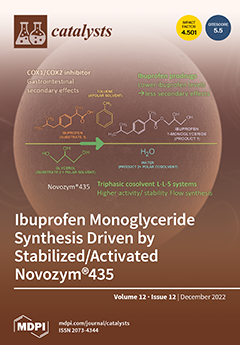In this work, we reported for the first time the effect of butanol isomerization on the photothermal production of hydrogen in the presence of a noble, metal-free Ti@TiO
2 core-shell photocatalyst. The experiments were performed in aqueous solutions of 1-BuOH, 2-BuOH, and t-BuOH
[...] Read more.
In this work, we reported for the first time the effect of butanol isomerization on the photothermal production of hydrogen in the presence of a noble, metal-free Ti@TiO
2 core-shell photocatalyst. The experiments were performed in aqueous solutions of 1-BuOH, 2-BuOH, and t-BuOH under Xe lamp irradiation (vis/NIR: 8.4 W, UV: 0.6 W) at 35–69 °C. The increase in temperature significantly enhanced H
2 formation, indicating a strong photothermal effect in the studied systems. However, in dark conditions, H
2 emission was not observed even at elevated temperatures, which clearly points out the photonic origin of H
2 photothermal formation. The rate of H
2 production followed the order of 1-BuOH >> 2-BuOH > t-BuOH in the entire range of studied temperatures. In the systems with 1-BuOH and 2-BuOH, hydrogen was the only gaseous product measured online in the outlet carrier argon using mass spectrometry. By contrast, a mixture of H
2, CH
4, and C
2H
6 was detected for t-BuOH, indicating a C–C bond scission with this isomer during photocatalytic degradation. The apparent activation energies, E
a, with 1-BuOH/2-BuOH isomers (20–21 kJ·mol
−1) was found to be larger than for t-BuOH (13 kJ·mol
−1). The significant difference in thermal response for 1-BuOH/2-BuOH and t-BuOH isomers was ascribed to the difference in the photocatalytic mechanisms of these species. The photothermal effect with 1-BuOH/2-BuOH isomers can be explained by the thermally induced transfer of photogenerated, shallowly trapped electron holes to highly reactive free holes at the surface of TiO
2 and the further hole-mediated cleavage of the O-H bond. In the system with t-BuOH, another mechanism could also contribute to the overall process through hydrogen abstraction from the C–H bond by an intermediate
•OH radical, leading to CH
3• group ejection. Formation of
•OH radicals during light irradiation of Ti@TiO
2 nanoparticle suspension in water has been confirmed using terephthalate dosimetry. This analysis also revealed a positive temperature response of
•OH radical formation.
Full article





